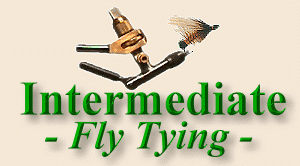It's finally time to move out of trout flies for a while and work on
flies that catch other fish. Much of this country and the world for that
matter, spend their time chasing fish other than trout. Of those "other"
fish, the bass seems to be one of the most popular.
Although there are many materials used in bass flies, deer hair is one
of the most commonly used materials of all. However, bass flies don't
usually try to imitate a specific insect found on or near the water.
Instead, they are often tied with wild and crazy colors and materials to
look like nothing found in the natural world. I guess it doesn't have to
look natural if it catches fish, and these wild looking creations do
catch fish.
In this first bass fly, we'll concentrate on getting the deer hair to do
what we want it to do. Although traditional deer hair bass flies have
eyes and rubber legs, I'll omit them for this first fly to concentrate on
getting the hair to spin right and trimming the head to the right shape.
Don't worry, we'll have plenty of opportunity to add legs and eyes
later.
Another thing I've noticed about bass bugs is there seems to be a lot of
room for variation between styles and methods. One tyer will use marabou
and the next one won't on the same pattern. One tyer will tie the
marabou on before the hackle; the next will tie it in reverse. And,
they'll both label their flies with the same name. For some reason, the
bass don't seem to mind very much.
If you don't have a lot of bright colored deer hair, you'll need to
spend a few bucks to get some. Buy the coarse kind of hair designed to
be used on bass bugs. (There is a difference.) You won't need all the
colors, but you should have at least three bright colors and black in
your inventory. You'll also need a hair packer if you want your deer
hair heads to turn out compact and sturdy. You'll need as many colors of
marabou and hackle as you have colors of hair. A couple of big hooks and
some heavy monofilament are a necessity. If you want to be consistent
with traditional bass flies, you'll need some 3mm or 4mm doll eyes and
some multi-colored rubber leg material. The final item you need you
should already have, and that is a few sharp razor blades.
If you don't have the same colors I use, don't quit. I'm probably using
an odd color combination anyway. Like I said before, my goal is to teach
you the methods, not the patterns. You can pick up any bass fly pattern,
and if you know the methods, all you need to do is purchase the right
materials and the fly will be yours to tie. Knowing how to perform the
steps is the key here. If your color combinations are different than
mine, who cares? The fish certainly don't.
Our goal with this week's task is to learn how to spin multiple colors
of deer hair and to trim them into a popper shaped head. If you want to
use purple and pink, be my guest. Just try to match some of the head
colors with similar colors in the tail. If you want to add eyes and
rubber legs, I'll pass on how it's done so you can do it.
Enough of that, let's tie a fly.
|











